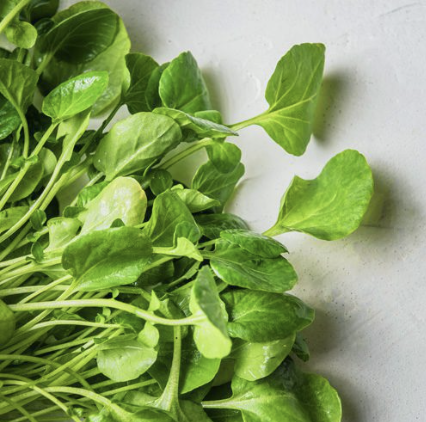Watercress
Latin name: Nasturtium officinale
🌱 Days to Sprout: 7-21
😋 Ready for Full Dose of plant food with true leaves or roots .5-inch long
✂️ Do not thin
🍅 Days to Maturity: 60
💡 Light Zone: Medium
📏 Plant Size: <1 ft
💚 Care Level: Beginner
Origin
Native to Europe and Asia, the ancient Romans referred to Watercress as “nasturtium”, which means “twisted nose”, in a nod to the plant’s slightly peppery flavor which can grow more bitter in maturity. In warm climates, Watercress grows wild in bodies of fresh running water, with the leaves floating on the surface while the roots anchor it below.
Qualities
Watercress is rich in vitamins and has a delicious, distinctive, peppery taste. It is an excellent source of vitamin A, C, and K, plus a good source of calcium and potassium. Watercress is rich in carotenoids and is considered to have antioxidant properties. The plant can grow a bit spindly and bushy, with new leaves growing off of branches in any direction.
Use
For the most nutrients, enjoy Watercress raw or lightly steamed. Add it to salads, sandwiches, eggs, or as a garnish to soups, stews, and more.
Care & Harvest
💡 Temperature: Prefers cooler temperatures (60-70°F).
✂️ Pruning: Remove leaves with brown spots if they appear. Check the roots monthly and trim any that are brown or extending past the yPod. If the plant begins to look spindly, prune all branches back at least ⅓ to encourage bushier growth.
🔎 Plant Health: Spider mites are a common pest, but you can use our prevention tricks to keep pests at bay!
🌿 Harvest: Harvesting frequently helps prolong the plant's life. Pinch off individual leaves, or use clean shears to cut stems above growth nodes. Leave ⅓ of the plant to ensure it continues growing for future harvests.
Harvest To Plate Recipe
Mushroom, Parmesan, and Watercress Omelet
Recipe Source: Martha Stewart
Ingredients
1/2 cup cremini mushrooms, sliced
1/4 cup Watercress
2 teaspoons extra-virgin olive oil
3 eggs
1 tablespoon unsalted butter
Kosher salt and freshly ground pepper
2 tablespoons finely grated Parmigiano-Reggiano, plus more for serving (optional)
Chopped chives and buttered toast for serving (optional)
Instructions
Cook 1/2 cup sliced cremini mushrooms in 2 teaspoons extra-virgin olive oil in an 8-inch nonstick skillet over medium heat until caramelized, 6 to 8 minutes. Season with salt and pepper; transfer to a bowl. Stir 1/4 cup packed watercress into mushrooms until slightly wilted. Return skillet to heat.
Using a fork (for good control), beat eggs with 1 teaspoon water until yolks and whites are completely combined and no streaks remain. The water helps incorporate them and steams while the omelet cooks, which puffs it up. Season with 1/8 teaspoon kosher salt and a few cracks of pepper.
Heat butter over medium-high heat until foaming; swirl to coat. When foam subsides, pour eggs into center of skillet. Let stand 10 seconds. Stir eggs with a rubber spatula in a circular motion with one hand while shaking skillet with the other, about 15 seconds. Reduce heat to medium. Working your way around skillet, gather outer set eggs toward center, then tip skillet so runny eggs move to outside edges, about 1 minute. Lightly spread any remaining runny eggs evenly over top and cook until creamy but no longer wet.
Add mushroom-watercress mixture and 2 tablespoons finely grated Parmigiano-Reggiano onto far side of omelet. Remove from heat. Tip pan away from you; gently slide spatula under near side of omelet and fold up and over cheese. Slide onto a warm plate. Top with more finely grated Parmigiano-Reggiano or chopped chives and serve with buttered toast, if desired.
Our Plant Health & Nutrition Team thoroughly tests each variety we offer to bring you the most flavorful and high-quality plants. We regularly rotate our plant portfolio, so please note, availability varies

